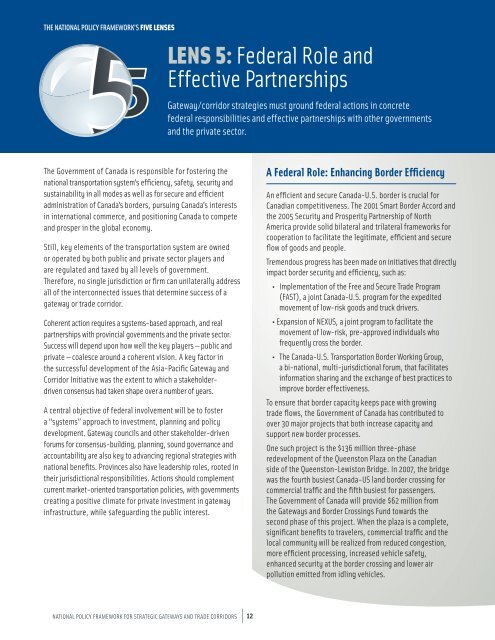GATEWAYS - Canada's Gateways | Portes et corridors du Canada
GATEWAYS - Canada's Gateways | Portes et corridors du Canada
GATEWAYS - Canada's Gateways | Portes et corridors du Canada
You also want an ePaper? Increase the reach of your titles
YUMPU automatically turns print PDFs into web optimized ePapers that Google loves.
THE NATIONAL POLICY FRAMEWORK’S FIVE LENSES<br />
The Government of <strong>Canada</strong> is responsible for fostering the<br />
national transportation system’s efficiency, saf<strong>et</strong>y, security and<br />
sustainability in all modes as well as for secure and efficient<br />
administration of <strong>Canada</strong>’s borders, pursuing <strong>Canada</strong>’s interests<br />
in international commerce, and positioning <strong>Canada</strong> to comp<strong>et</strong>e<br />
and prosper in the global economy.<br />
Still, key elements of the transportation system are owned<br />
or operated by both public and private sector players and<br />
are regulated and taxed by all levels of government.<br />
Therefore, no single jurisdiction or firm can unilaterally address<br />
all of the interconnected issues that d<strong>et</strong>ermine success of a<br />
gateway or trade corridor.<br />
Coherent action requires a systems-based approach, and real<br />
partnerships with provincial governments and the private sector.<br />
Success will depend upon how well the key players — public and<br />
private — coalesce around a coherent vision. a key factor in<br />
the successful development of the asia-Pacific Gateway and<br />
Corridor Initiative was the extent to which a stakeholder-<br />
driven consensus had taken shape over a number of years.<br />
a central objective of federal involvement will be to foster<br />
a “systems” approach to investment, planning and policy<br />
development. Gateway councils and other stakeholder-driven<br />
forums for consensus-building, planning, sound governance and<br />
accountability are also key to advancing regional strategies with<br />
national benefits. Provinces also have leadership roles, rooted in<br />
their jurisdictional responsibilities. actions should complement<br />
current mark<strong>et</strong>-oriented transportation policies, with governments<br />
creating a positive climate for private investment in gateway<br />
infrastructure, while safeguarding the public interest.<br />
NaTIoNal PolICy FRaMEWoRk FoR STRaTEGIC GaTEWayS aNd TRadE CoRRIdoRS<br />
LENS 5: Federal Role and<br />
Effective Partnerships<br />
Gateway/corridor strategies must ground federal actions in concr<strong>et</strong>e<br />
federal responsibilities and effective partnerships with other governments<br />
and the private sector.<br />
12<br />
A Federal Role: Enhancing Border Efficiency<br />
an efficient and secure <strong>Canada</strong>-U.S. border is crucial for<br />
Canadian comp<strong>et</strong>itiveness. The 2001 Smart Border accord and<br />
the 2005 Security and Prosperity Partnership of North<br />
america provide solid bilateral and trilateral frameworks for<br />
cooperation to facilitate the legitimate, efficient and secure<br />
flow of goods and people.<br />
Tremendous progress has been made on initiatives that directly<br />
impact border security and efficiency, such as:<br />
• Implementation of the Free and Secure Trade Program<br />
(FaST), a joint <strong>Canada</strong>-U.S. program for the expedited<br />
movement of low-risk goods and truck drivers.<br />
• Expansion of NEXUS, a joint program to facilitate the<br />
movement of low-risk, pre-approved indivi<strong>du</strong>als who<br />
frequently cross the border.<br />
• The <strong>Canada</strong>-U.S. Transportation Border Working Group,<br />
a bi-national, multi-jurisdictional forum, that facilitates<br />
information sharing and the exchange of best practices to<br />
improve border effectiveness.<br />
To ensure that border capacity keeps pace with growing<br />
trade flows, the Government of <strong>Canada</strong> has contributed to<br />
over 30 major projects that both increase capacity and<br />
support new border processes.<br />
one such project is the $136 million three-phase<br />
redevelopment of the Queenston Plaza on the Canadian<br />
side of the Queenston-lewiston Bridge. In 2007, the bridge<br />
was the fourth busiest <strong>Canada</strong>-US land border crossing for<br />
commercial traffic and the fifth busiest for passengers.<br />
The Government of <strong>Canada</strong> will provide $62 million from<br />
the <strong>Gateways</strong> and Border Crossings Fund towards the<br />
second phase of this project. When the plaza is a compl<strong>et</strong>e,<br />
significant benefits to travelers, commercial traffic and the<br />
local community will be realized from re<strong>du</strong>ced congestion,<br />
more efficient processing, increased vehicle saf<strong>et</strong>y,<br />
enhanced security at the border crossing and lower air<br />
pollution emitted from idling vehicles.


